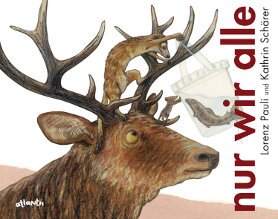Lorenz PauliKathrin Schärer
nur wir alle
[Just all of us]
- Atlantis Verlag
- Zurich 2012
- ISBN 978-3-7152-0642-4
- 32 Pages
- 3 Suitable for age 4 and above
- Publisher’s contact details
Lorenz Pauli
nur wir alle
[Just all of us]
Sample translations
Review
There are animals without number in children’s picture books, but very few with a truly characterful visage. Right now I have a picture book before me, the very cover of which offers just such a visage in the form of a stag’s head. The depiction of the animal would strike us as entirely naturalistic if it weren’t for the stag’s upward gaze, part anxious, part solicitous, in the direction of his mighty antlers. And up there we see three other animals romping around — very much smaller, but no less characterful. So what on earth are they up to?
Before we’ve read even a single page of Lorenz Pauli’s story “Nur wir alle” [Just all of us] or glimpsed even a single one of the Kathrin Schärer illustrations that grace them, we’re already agog to know what strange events are taking place here. One thing is clear: whatever else they may be, the four creatures on the front cover are not rivals, let alone enemies; something very amicable is going on between these markedly different characters, who are joined in the course of the story by a magpie and an enormous bear.
In the long history of picture books, how many animals have gone flitting across their pages in order to fulfil their mission as greater or lesser embodiments of virtue? But precious few of them have stuck in our own memories from childhood days — and it is even more challenging for today’s generation of very young bookworms.
In this instance, too, it is very much a case of moral messages. It’s all about taking delight in your own activities, about displaying openness and curiosity in the face of strangers who differ from you in appearance, behaviour and ideas. It’s about that sometimes tricky process of establishing relationships, about putting prejudices aside, about negotiating ground rules for associating and playing with one another.
Such themes are of course no more new to picture books than is the deployment of whole legions of all imaginable species of animals as moral messengers. What is very striking, however, is the way that the writer and illustrator choose to present their story. Lorenz Pauli’s use of brief, trenchant, witty exchanges and statements, his insertion of mini commentaries that serve to heighten the tension — these things are readily understood by children, and can make a lasting impression on them. Kathrin Schärer, for her part, complements Pauli’s verbal artistry perfectly with her mixed-media illustrations: close-ups of the animals (with characterful heads and sundry incidents depicted in sharp detail); facial expressions and body postures that are exactly right; constant focus on the essence of the action; no background, or the merest hint of one, to avoid distracting attention from the main story-line; on top of all that, dramatic depictions of fear and pleasure alike. And what a splendid tableau at the end, full of vitality, wit and hope!
It makes no difference whether children read this story for themselves or have it read to them: ‘Just all of us’ could easily lodge itself in the minds of today’s children just as various animal tales lodged themselves in the minds of us adults when we were young.

Before we’ve read even a single page of Lorenz Pauli’s story “Nur wir alle” [Just all of us] or glimpsed even a single one of the Kathrin Schärer illustrations that grace them, we’re already agog to know what strange events are taking place here. One thing is clear: whatever else they may be, the four creatures on the front cover are not rivals, let alone enemies; something very amicable is going on between these markedly different characters, who are joined in the course of the story by a magpie and an enormous bear.
In the long history of picture books, how many animals have gone flitting across their pages in order to fulfil their mission as greater or lesser embodiments of virtue? But precious few of them have stuck in our own memories from childhood days — and it is even more challenging for today’s generation of very young bookworms.
In this instance, too, it is very much a case of moral messages. It’s all about taking delight in your own activities, about displaying openness and curiosity in the face of strangers who differ from you in appearance, behaviour and ideas. It’s about that sometimes tricky process of establishing relationships, about putting prejudices aside, about negotiating ground rules for associating and playing with one another.
Such themes are of course no more new to picture books than is the deployment of whole legions of all imaginable species of animals as moral messengers. What is very striking, however, is the way that the writer and illustrator choose to present their story. Lorenz Pauli’s use of brief, trenchant, witty exchanges and statements, his insertion of mini commentaries that serve to heighten the tension — these things are readily understood by children, and can make a lasting impression on them. Kathrin Schärer, for her part, complements Pauli’s verbal artistry perfectly with her mixed-media illustrations: close-ups of the animals (with characterful heads and sundry incidents depicted in sharp detail); facial expressions and body postures that are exactly right; constant focus on the essence of the action; no background, or the merest hint of one, to avoid distracting attention from the main story-line; on top of all that, dramatic depictions of fear and pleasure alike. And what a splendid tableau at the end, full of vitality, wit and hope!
It makes no difference whether children read this story for themselves or have it read to them: ‘Just all of us’ could easily lodge itself in the minds of today’s children just as various animal tales lodged themselves in the minds of us adults when we were young.
Translated by John Reddick

By Siggi Seuß
Siggi Seuß, freelance journalist, radio script writer and translator, has been writing reviews of books for children and young people for many years.
